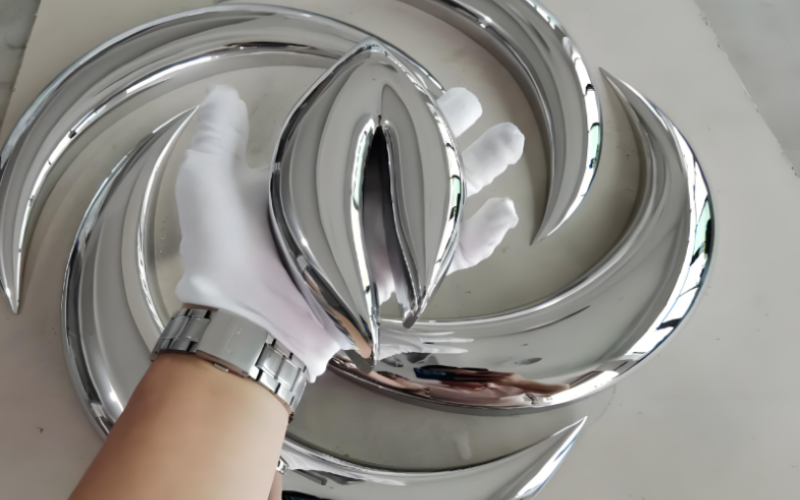Contents
How to Buff & Polish Stainless Steel?
- John

We have introduced in detail how to polish stainless steel, including the possible polishing effects, specific polishing steps, different polishing methods and the preparation of natural polishing agents. Whether you are a home user or a professional, you can find the stainless steel polishing method that suits you through this article to make your stainless steel products look brand new.
Why Polish Stainless Steel?
There are several main reasons to polish stainless steel:
Aesthetics: Polishing can restore the luster of stainless steel and make it look more beautiful. The bright surface of stainless steel products can enhance its overall visual effect and make the product more attractive. Whether it is used for kitchen appliances or automotive parts, the bright stainless steel surface can bring higher texture and market value.
Reduce corrosion: Polishing can reduce cracks and holes on the metal surface and reduce the risk of corrosion. Unpolished surfaces are more likely to accumulate dirt and moisture, leading to the formation of rust. The polished stainless steel surface is smoother, reducing the chance of corrosive substances adhering.
Remove contaminants: Polishing can remove tiny contaminants on the surface, making it cleaner. This is especially important for stainless steel products that require high cleanliness, such as food processing equipment and medical devices. The key to improving the safety and hygiene level of stainless steel products is to effectively remove contaminants from their surface.
The Difference between Buff and Polish
In the polishing process, buff and polish are two common terms:
Buffing: refers to polishing with a cloth wheel and polishing agent, which is usually used to remove fine scratches and blemishes on the surface to make the surface smooth. Buffing generally uses a coarser polishing agent and operates at a higher pressure to remove deeper scratches and blemishes. Buffing is the preliminary step of the polishing process and is usually used for preliminary treatment of large areas.
Polishing: refers to the use of finer polishing materials to achieve a mirror effect or a specific gloss on the surface. Polishing uses fiber polishing agents, and its main purpose is to enhance the gloss of the surface and achieve a higher aesthetic effect. Polishing is a delicate step in the polishing process, which is used for the final surface treatment to achieve the desired gloss and texture of stainless steel.
Step 1——How to Clean Stainless Steel
Clean the stainless steel surface thoroughly before the polishing step. Use a mild detergent and a clean sponge to clean the surface, making sure to remove all stains and residues. Avoid using steel wool or other cleaning tools that may damage stainless steel.
Choose a cleaning agent: Choose a mild detergent, such as dishwashing liquid, and use a soft sponge or cloth to clean the stainless steel surface, ensuring that there is no oil, dust, and other contaminants on the stainless steel surface. Using a mild detergent can effectively remove grease and dirt on the surface without damaging the stainless steel surface.
Cleaning process: Rinse the detergent residue thoroughly with clean water, then wipe the surface carefully with a clean cloth and keep it dry. Make sure there is no residual detergent to avoid affecting the subsequent polishing effect. Pay attention to details during the cleaning process to ensure that every corner is clean.
Dealing with rough areas: For areas with obvious scratches or uneven surfaces, you can use 80 to 120 grit sandpaper for preliminary grinding to make the surface flat. Pay attention to the strength when grinding to avoid excessive grinding and causing surface depression.
Learn more about how to clean stainless steel.
Step 2——How to Sand Stainless Steel
Use sandpaper or grinding wheel: Use sandpaper or grinding wheel of different grits for grinding from coarse to fine. Usually start with coarse sandpaper (such as 80 mesh) and gradually transition to finer sandpaper (such as 240 mesh, 400 mesh, etc.). The purpose of this step is to remove most of the roughness and unevenness of the surface.
Step 3——How to Buff Stainless Steel
Grinding steps: Start with 150 to 240 grit sandpaper, then gradually use finer sandpaper, such as 400 grit, 600 grit, 1200 grit, until the surface is smooth. Each time you change the sandpaper, the grinding direction should be 90 degrees from the last time to ensure a uniform surface. Maintain uniform force and speed during the grinding process and avoid staying in the same position for too long.
Use a grinder: For grinding a larger area, you can use a grinder and set the grinding speed between 4000 and 6500 RPM to maintain the continuity and uniformity of the grinding action. Using a grinder can improve efficiency and ensure the consistency of the grinding effect.
Step 4——How to Polish Stainless Steel
Polishing includes two main methods: manual polishing and machine polishing.
Manual Polishing
Tool preparation: Prepare polishing agent and clean cloth. Common polishing agents include green sticks, white sticks, etc., which can be selected as needed. Manual polishing is suitable for the treatment of small areas or delicate parts.
Operation steps: Apply a small amount of polish to a clean cloth, then wipe the stainless steel surface gently and evenly with gentle circular motions. Repeat until the surface is bright. During manual polishing, maintain uniform force and speed to avoid excessive force causing surface damage.
Finishing the work: Finally, wipe the surface with a clean dry cloth to remove excess polish to ensure that the surface is smooth and residue-free and maintains the best condition. After polishing, wipe it again with a clean cloth to ensure that the surface is smooth and flawless.
Machine Polishing
Tool preparation: Use an electric tool with a polishing wheel and a special polishing agent. Commonly used polishing wheels include red air wheels and pink air wheels. Machine polishing is suitable for large areas or surface treatments that require high gloss.
Operation steps: Apply the polishing agent evenly on the polishing wheel, turn on the machine, and polish at a moderate speed. Keep the polishing wheel moving to avoid staying in the same position for too long to prevent overheating or damage to the stainless steel surface. During the polishing process, pay attention to maintaining uniform force and speed to ensure the consistency of the polishing effect.
Note: After each step, check the surface for scratches or uneven areas, and rework if necessary. Pay attention to details during the polishing process to ensure that every part is polished evenly.
Other Polishing Methods
In addition, we continue to introduce you to another 5 polishing methods so that you can choose the appropriate polishing method according to the actual situation.
1. Chemical Polishing
Method overview: Chemical polishing uses the action of chemical media to make the microscopic protrusions on the surface of the material dissolve faster than the concave parts, ultimately achieving a smooth surface.
Required materials: Chemical polishing liquid (prepared with a variety of chemical reagents).
Steps:
- Immerse the stainless steel workpiece in the chemical polishing liquid.
- Control the polishing time and temperature according to the formula of the polishing liquid and the specific requirements of the workpiece.
- Take out the workpiece, clean it and remove the residual polishing liquid.
2. Electrolytic Polishing
Method overview: Electrolytic polishing is to use electrolysis to dissolve the stainless steel surface in a specific electrolyte to obtain a smooth and bright surface.
Required materials: Electrolyte (prepared with a variety of chemical substances), electrolytic equipment.
Steps:
- Put the stainless steel workpiece as the anode and put it into the electrolyte.
- Apply appropriate voltage and current to make the workpiece surface dissolve anodically.
- Control the electrolysis time and current density to achieve the desired polishing effect.
- Take out the workpiece, clean it and remove the residual electrolyte.
3. Ultrasonic Polishing
Method overview: Ultrasonic polishing technology uses the strong oscillation effect of ultrasound to drive abrasive particles to perform high-frequency and fine grinding and polishing operations on the surface of the workpiece, thereby achieving a smooth surface.
Required equipment: Ultrasonic polishing machine, abrasive suspension.
Steps:
- Put the workpiece into the abrasive suspension.
- Start the ultrasonic polishing machine so that the abrasive grinds and polishes the workpiece surface under the oscillation of ultrasound.
- Control the polishing time and the power of ultrasound to achieve the desired polishing effect.
4. Fluid Polishing
Method overview: Fluid polishing uses high-speed liquid and abrasive particles to wash the surface of the workpiece to achieve polishing.
Required equipment: Fluid polishing machine, abrasive jet device.
Steps:
- Mix the abrasive with water or other liquid to form an abrasive suspension.
- Use an abrasive jet device to spray the abrasive suspension onto the surface of the workpiece at high speed.
- The abrasive flushes the surface of the workpiece under high-speed flow to remove the rough layer and uneven parts of the surface.
5. Magnetic Grinding and Polishing
Method overview: Magnetic grinding and polishing uses a magnetic field to form a magnetic abrasive into a brush shape to grind the workpiece.
Required equipment: Magnetic grinding machine, magnetic abrasive.
Steps:
- Put the magnetic abrasive into the magnetic grinding machine.
- Start the grinder, and the magnetic field forms an abrasive brush.
- Put the workpiece in, and the abrasive brush grinds and polishes its surface.
What Kind of Polishing Effect Do You Want to Achieve?
Different polishing effects require different techniques and tools.
Polish Brushed Stainless Steel
The brushed finish leaves fine parallel lines on the surface of the stainless steel using a brush or sandpaper. This effect is often used on kitchen appliances to prevent them from reflecting harsh light under strong light. The commonly used sandpaper has a grit of 150 to 240. The brushed finish not only has an aesthetic effect, but also reduces surface reflections, making it suitable for places where lower reflectivity is required.
Mirror Polish Stainless Steel
Mirror polishing makes the surface of stainless steel highly reflective and is often used in places where a high gloss is required, such as decorative metal parts. Achieving the mirror effect requires the use of ultra-fine sandpaper (such as 2000 grit) and high-quality polishing compounds. Mirror polishing steps are more complicated and require multiple grinding and polishing to achieve the desired effect. The mirror-polished surface is not only as bright as a mirror, but also has good stain resistance, making it easy to clean and maintain.
Gloss Finish Stainless Steel
Gloss polishing increases the corrosion resistance of stainless steel and is suitable for applications such as automotive parts that require a high gloss. Using high-quality polishing compounds and polishing wheels, a gloss effect similar to chrome can be achieved. Gloss polishing usually requires multiple sanding with 400-grit, 600-grit, and 1200-grit sandpaper before polishing. The surface of gloss polish has a high gloss and reflective effect, which can enhance the texture and visual effect of the product.
Matte Finish Stainless Steel
Matte polishing does not require much time and effort, and is usually used for practical items such as kitchen sinks and workbenches. Matte effects can be achieved using 240-grit and 300-grit sandpaper. Matte surfaces are not easy to leave fingerprints and stains, suitable for daily use and maintenance. Matte polishing has a soft texture and does not reflect strong light, suitable for places where low reflectivity and durability are required.
Easy Polishing Methods at Home
For stainless steel items in the home, there are some simple methods for polishing:
Cleaning the surface: Wash the stainless steel surface with warm water and dishwashing liquid to ensure that there are no stains. Wipe gently with a soft cloth or sponge, and do not use hard materials such as steel wool. During the cleaning process, make sure that every corner is thoroughly cleaned to eliminate residue.
Apply polish: Apply a small amount of olive oil or baby oil to the cloth and rub the surface in a circular motion. Repeat until the surface is shiny. Maintain uniform force and speed during the application process to ensure a smooth and mark-free surface.
Polishing: For deeper scratches, you can first gently polish with fine sandpaper and then polish. Choose the appropriate grit of sandpaper and polish gradually until the surface is smooth. Pay attention to the force during the polishing process to avoid excessive polishing and causing surface depressions.
Wipe clean: Wipe off excess polish with a clean cloth to ensure a smooth and mark-free surface. After polishing, use a clean cloth to carefully wipe the surface again to ensure that all polish or grease has been completely removed.
What Is the Best Method for Polishing Stainless Steel?
- Step 1: Clean the surface with warm water and mild soap to remove dirt and grease.
- Step 2: Use a polishing compound like green rouge or white rouge and a soft cloth or buffer.
- Step 3: Buff in the direction of the grain using light pressure.
- Step 4: Finish with a microfiber cloth for a high-gloss shine.
How Do You Polish Stainless Steel without a Polisher?
- Step 1: Clean the surface with vinegar or soap and water.
- Step 2: Use a small amount of baking soda or white toothpaste as a mild abrasive.
- Step 3: Rub the stainless steel in the direction of the grain with a soft cloth.
- Step 4: Rinse, dry, and buff with a clean microfiber cloth for shine.
How to Polish Stainless Steel Jewelry?
- Step 1: Soak the jewelry in warm soapy water for a few minutes.
- Step 2: Gently scrub using a soft toothbrush to remove any dirt or residue.
- Step 3: Dry with a soft cloth, then apply a stainless steel jewelry polish or use a small amount of baking soda mixed with water.
- Step 4: Rub the jewelry gently in circular motions, rinse, and buff to a shine with a soft cloth.
What Is the Best Polishing Compound for Stainless Steel?
Polishing agents are chemicals that make the surface of objects smooth and shiny. They are widely used in polishing hard materials such as stainless steel, metal products, car paint and glass.
The best polishing compound for stainless steel depends on the finish you want to achieve, but some of the most commonly used and effective options include:
| Suspension Polishing Agents | prepared with abrasive micropowder and distilled water, and the particle size can be adjusted according to needs |
| Paste Polishing Paste | made of ingredients such as diamond micropowder, fine grinding, good polishing effect |
| Spray Polishing Agents | easy to use, suitable for fast and efficient polishing operations |
| Green Rouge (Chrome Oxide) | Ideal for achieving high-gloss and mirror finishes on stainless steel; fine abrasive for hard metals. |
| White Rouge | Used for final polishing to achieve a brilliant shine; less abrasive, perfect for finishing touches. |
| Gray Stainless Steel Compound | Best for initial polishing and removing scratches; medium abrasive for smoothing imperfections. |
| Blue Rouge | Great for final finishing to get a smooth, bright polish; less abrasive, suitable for buffing stages. |
| Felt Polishing Pads with Polishing Paste | Suitable for hand or machine polishing; offers precise control when used with polishing paste. |
DIY Natural Polishing Agents
Polishing requires a combination of precision and patience, which is the key to achieving perfect results. Here are some practical tips and suggestions to help you achieve the best polishing results.
Baking soda: Suitable for polishing minor scratches, use a wet sponge or cloth to dip baking soda and wipe along the grain of stainless steel. Baking soda is slightly abrasive and can effectively remove stains and minor scratches. Using baking soda for polishing is economical and environmentally friendly, and suitable for daily household use.
Vinegar: Use diluted vinegar to remove dirt and sticky residues, and then wipe the surface with olive oil. Vinegar has good cleaning ability, but it should be diluted when used to avoid damaging the stainless steel surface. The combination of vinegar and olive oil can not only clean the stainless steel surface, but also increase its gloss.
Baby oil and dishwashing liquid: Wash the stainless steel surface with warm water and dishwashing liquid, and apply a small amount of baby oil to polish after drying. Baby oil can increase the gloss of the stainless steel surface. The combination of dishwashing liquid and baby oil is suitable for cleaning and polishing stainless steel in home kitchens and bathrooms.
Will Vinegar Polish Stainless Steel?
Yes, vinegar can clean and lightly polish stainless steel by removing smudges and fingerprints. For a higher shine, follow up with a small amount of olive oil or a stainless steel polish after cleaning with vinegar.
Polishing Tips and Suggestions
The polished surface can show a glossy and reflective effect, which significantly enhances the appearance and visual appeal of the product.
- Don’t rush when polishing, use the right amount of polish each time, and avoid over-polishing. Maintain uniform pressure and speed when polishing to ensure a smooth surface.
- Polishing lines should be close together and avoid excessive overlap to ensure a uniform surface. During the polishing process, the surface effect should be checked regularly and problems should be adjusted in time.
- Before each step of polishing, check the surface for scratches or flaws. Rework can be done if necessary to ensure the perfect final effect.
- Polishing tools should be kept clean, and polishing wheels and polishing cloths should be replaced regularly to avoid cross contamination. The care and maintenance of tools are essential for the stability and consistency of polishing effects.
Get Satisfactory Stainless Steel!
Using the right polish and tools, combined with the right approach, can effectively extend the life of your stainless steel items.
We offer a wide range of high-quality stainless steel utensils that are specially designed to resist fingerprints and smudges and provide easy cleaning. You can customize the surface effect to your preference. If you need to purchase, please feel free to contact us.
- Stainless Steel Grades
- 300 Series Stainless Steel
- 303 Stainless Steel
- 304 Stainless Steel
- 305 Stainless Steel
- 308 Stainless Steel
- 316 Stainless Steel
- 316N Stainless Steel
- 409 Stainless Steel
- 410 Stainless Steel
- 416 Stainless Steel
- 420 Stainless Steel
- 430 Stainless Steel
- 410HT And 410L Stainless Steels
- 410S Stainless Steel
- 440 Stainless Steel
- 436 Stainless Steel
- 301 Stainless Steel
- 201 Stainless Steel
- 202 Stainless Steel
- 444 Stainless Steel
- 405 Stainless Steel
- 302 Stainless Steel
- 309 Stainless Steel
- 314 Stainless Steel
- 321 Stainless Steel
- 347 Stainless Steel
- 408 Stainless Steel
- 422 Stainless Steel
- 431 Stainless Steel
- 434 Stainless Steel
- 414 Stainless Steel
- 430FR Stainless Steel
- 13-8 PH Stainless Steel
- 317 | 317L Stainless Steel
- 616 Stainless Steel
- 630 Stainless Steel
- 904L Stainless Steel
- A2 Stainless Steel
- 304 vs 304L Stainless Steel
- 304 VS 316 Stainless Steel
- 304 vs 409 Stainless Steel
- 304 vs 430 Stainless Steel
- 410 Stainless Steel vs 304
- 18/0 vs 18/10
- 18/0 Stainless Steel
- 18/8 Stainless Steel
- 18/10 Stainless Steel
Comparisons















